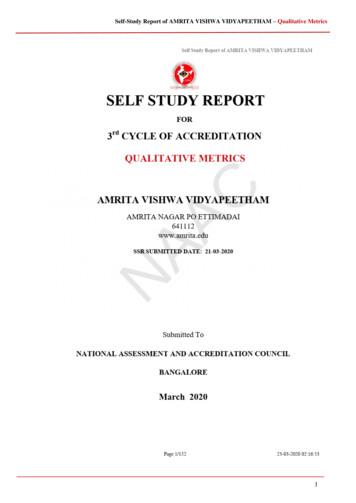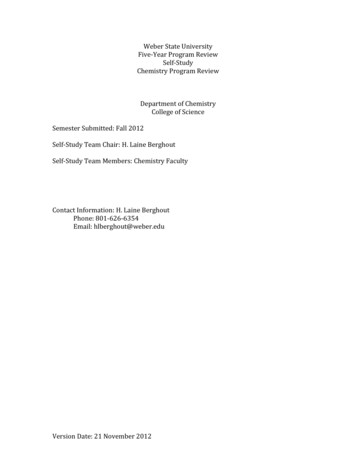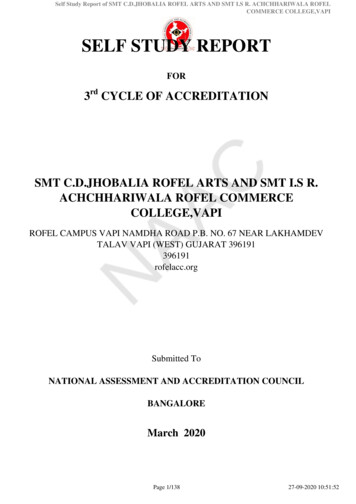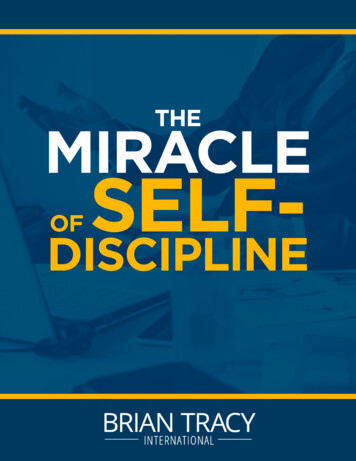
Transcription
Self-Study Report of AMRITA VISHWA VIDYAPEETHAM – Qualitative Metrics1
Self-Study Report of AMRITA VISHWA VIDYAPEETHAM – Qualitative MetricsTABLE OF CONTENTS1.EXECUTIVE SUMMARY 51.1INTRODUCTION 51.2STRENGTHS, WEAKNESSES, OPPORTUNTIES, and CHALLENGES (SWOC) 7Institutional Strengths 7Institutional Weaknesses 8Institutional Opportunities 8Institutional Challenges 91.3CRITERIA WISE SUMMARY 10Criterion 1 - Curricular Aspects 10Criterion 2 - Teaching-learning and Evaluation 10Criterion 3 - Research, Innovations and Extension 11Criterion 4 - Infrastructure and Learning Resources 13Criterion 5 - Student Support and Progression 14Criterion 6 - Governance, Leadership and Management 14Criterion 7 - Institutional Values and Best Practices 154. QUALITY INDICATOR FRAMEWORK (QIF) 17Criterion 1 - Curricular Aspects 171.1Curriculum Design and Development 171.1.1 Curricula developed and implemented have relevance to the local, national, regional and globaldevelopmental needs which is reflected in Programme outcomes (POs), Programme SpecificOutcomes(PSOs) and Course Outcomes(COs) of the Programmes offered by the Institution. 171.3Curriculum Enrichment 201.3.1 Institution integrates crosscutting issues relevant to Professional Ethics ,Gender, HumanValues ,Environment and Sustainability into the Curriculum 20Criterion 2 – Teaching- Learning and Evaluation 222.2Catering to Student Diversity 222.2.1 The institution assesses the learning levels of the students and organizes special Programmes foradvanced learners and slow learners 222.3Teaching- Learning Process 242.3.1 Student centric methods, such as experiential learning, participative learning and problemsolving methodologies are used for enhancing learning experiences 242.3.2 Teachers use ICT enabled tools including online resources for effective teaching and learningprocesses 262.5Teacher Profile and Quality 272.5.3 IT integration and reforms in the examination procedures and processes (continuous internalassessment and end-semester assessment) have brought in considerable improvement in examinationmanagement system of the institution 272.6Student Performance and Learning Outcomes 302.6.1 The institution has stated learning outcomes (generic and programme specific)/graduate2
Self-Study Report of AMRITA VISHWA VIDYAPEETHAM – Qualitative Metricsattributes which are integrated into the assessment process and widely publicized through the websiteand other documents 302.6.2 Attainment of Programme outcomes, Programme specific outcomes and course outcomes areevaluated by the institution 31Criterion 3 - Research, Innovations and Extension 333.1Promotion of Research and Facilities 333.1.1 The institution Research facilities are frequently updated and there is well defined policy forpromotion of research which is uploaded on the institutional website and implemented 333.3Innovation Ecosystem 343.3.1 Institution has created an ecosystem for innovations including Incubation Centre and otherinitiatives for creation and transfer of knowledge. 343.5 Consultancy 373.5.1 Institution has a policy on consultancy including revenue sharing between the institution and theindividual and encourages its faculty to undertake consultancy. 373.6Extension Activities 383.6.1 Extension activities in the neighbourhood community in terms of impact and sensitizingstudents to social issues and holistic development during the last five years. 38Criterion 4 - Infrastructure and Learning Resources 414.1Physical Facilities 414.1.1 The institution has adequate facilities for teaching - learning. viz., classrooms, laboratories,computing equipment, etc. 414.1.2 The institution has adequate facilities for cultural activities, yoga, games (indoor, outdoor) andsports. (gymnasium, yoga centre, auditorium, etc.) 424.1.3 Availability of general campus facilities and overall ambience Response: 444.2Library as a Learning Resource 454.2.1 Library is automated using Integrated Library Management System (ILMS) and has digitizationfacility 454.3 IT Infrastructure 474.3.2 Institution has an IT policy, makes appropriate budgetary provision and updates its IT facilitiesincluding Wi-Fi facility 474.4 Maintenance of Campus Infrastructure 494.4.2 There are established systems and procedures for maintaining and utilizing physical, academicand support facilities - laboratory, library, sports complex, computers, classrooms etc. 49Criterion 5 - Student Support and Progression 525.3 Student Participation and Activities 525.3.2 Presence of Student Council and its activities for institutional development and student welfare.525.4 Alumni Engagement 545.4.1 The Alumni Association / Chapters (registered and functional) contributes significantly to thedevelopment of the institution through financial and other support services. 54Criterion 6 - Governance, Leadership and Management 573
Self-Study Report of AMRITA VISHWA VIDYAPEETHAM – Qualitative Metrics6.1 Institutional Vision and Leadership 576.1.1 The institution has a clearly stated vision and mission which are reflected in its academic andadministrative governance. 576.1.2 The effective leadership is reflected in various institutional practices such as decentralizationand participative management. 596.2Strategy Development and Deployment 606.2.1 The institutional Strategic plan is effectively deployed. 606.2.2 The functioning of the institutional bodies is effective and efficient as visible from policies,administrative setup, appointment and service rules, procedures, etc. 626.3Faculty Empowerment Strategies 646.3.1 The institution has a performance appraisal system, promotional avenues and effective welfaremeasures for teaching and non-teaching staff . 646.4 Financial Management and Resource Mobilization 666.4.1 Institutional strategies for mobilisation of funds and the optimal utilisation of resources 666.4.4 Institution conducts internal and external financial audits regularly Response: 686.5 Internal Quality Assurance System 696.5.1 Internal Quality Assurance Cell (IQAC) has contributed significantly for institutionalizing thequality assurance strategies and processes by constantly reviewing the teaching learning process,structures & methodologies of operations and learning outcomes at periodic intervals. 696.5.3 Incremental improvements made for the preceding five years with regard to quality (in case offirst cycle), Post accreditation quality initiatives (second and subsequent cycles). 70Criterion 7 - Institutional Values and Best Practices 737.1Institutional Values and Social Responsibilities 737.1.1 Measures initiated by the Institution for the promotion of gender equity during the last fiveyears. 737.1.3 Describe the facilities in the Institution for the management of the following types of degradableand non-degradable waste (within 500 words) 747.1.8 Describe the Institutional efforts/initiatives in providing an inclusive environment i.e., toleranceand harmony towards cultural, regional, linguistic, communal socioeconomic and other diversities(within 500 words). 767.1.9 Sensitization of students and employees of the Institution to the constitutional obligations:values, rights, duties and responsibilities of citizens (within 500 words). 787.1.11 Institution celebrates / organizes national and international commemorative days, events andfestivals (within 500 words). 807.2Best Practices 827.2.1 Describe two best practices successfully implemented by the Institution as per NAAC formatprovided in the Manual. 827.3Institutional Distinctiveness 897.3.1 Portray the performance of the Institution in one area distinctive to its priority and thrust within1000 words 895.CONCLUSION 944
Self-Study Report of AMRITA VISHWA VIDYAPEETHAM – Qualitative Metrics1. EXECUTIVE SUMMARY1.1 INTRODUCTIONAmrita Vishwa Vidyapeetham (Amrita), established in 2003 under section 3 of UGC Act of 1956, is amulti- disciplinary Deemed to be University that offers more than 180 Academic Programs, through 10Departments across 6 Campuses in three South Indian states of Kerala, Tamil Nadu, and Karnataka.The renowned humanitarian leader, Sri Mata Amritanandamayi Devi, popularly known as Amma, is theChancellor and guiding light of Amrita Vishwa Vidyapeetham. In its sixth year, it became the youngestinstitution to be accredited with ‘A’ grade by the NAAC. Spread over 900 acres with eight million squarefeet built-up space, Amrita is one of India’s top-ranked private Institutions, selected for the prestigiousaward of Institution of Eminence status by MHRD. The University has over 19,000 students and 1,300faculty serving in a spirit of dedicated diligence, wherein the latest advances in pedagogy and research areintegrated with compassion and service mindedness.VisionOur vision is to be an exemplary institution that thrives on its commitment to the transformative power ofvalue- based education, providing the impetus to develop the expansiveness to harmonize both scientificknowledge and spiritual understanding, so as to utilize knowledge for societal benefit and contribute to aprosperous and sustainable future for all.MissionAmma’s profound mission of providing education for life, and emphasis on compassion driven research,has shaped Amrita as a unique institution:5
Self-Study Report of AMRITA VISHWA VIDYAPEETHAM – Qualitative Metrics[i] Education for LifeThere are two types of education: education for living and education for life. Studying to become aprofessional is education for a living, while education for life requires an understanding of the essentialhuman values. At Amrita, we believe that education should also impart a culture of the heart, based onenduring values and inner strength. Amrita’s culture of education helps to inculcate in our students the rightethos to be rooted in the values of Dharma (righteousness), Karuna (compassion) and Shraddha(mindfulness). Endowed with qualities of acceptance, patience, self-confidence, perseverance andenthusiasm, the benefit of humanity will become uppermost in the students’ thoughts, words and actions.They will then pioneer innovative solutions for the benefit of all humankind, leading to sustainable healthand prosperity for all. This resonates with the ancient Sanskrit prayer ‘Lokah Samastah Sukhino Bhavantu’.It is a reminder of our deeper connection to the entire world around us, “May our work contribute to thehappiness of all beings.”[ii] Compassion Driven ResearchOur motivation to pursue research is focused on alleviating major global problems related to poverty,starvation, sickness, environmental pollution and contamination. We believe that if we could transformcompassion from a mere word into a path of action, we would be able to address most of the world’sproblems. If we take this step courageously, then our research and its outcomes will have a special impact,spontaneity, and power. This has translated into many latest advancements and innovations that haveculminated in greater societal benefit.[iii] Global ImpactAt Amrita, we stand united in our mission towards solving globally recognized scientific and societalchallenges, including environment, development, and health. Amrita stands at the strategic juncture of twostreams of cultures: East and West. It is our vision to bring the two together to bridge the divide throughmeaningful collaborations with world class universities and innovative approaches that will benefit theentire planet.6
Self-Study Report of AMRITA VISHWA VIDYAPEETHAM – Qualitative Metrics1.2 STRENGTHS, WEAKNESSES, OPPORTUNTIES, andCHALLENGES (SWOC)Institutional StrengthsAmrita exemplifies multi-disciplinary academic excellence through the exceptional quality of its educationsystem that is modern, comprehensive, inspiring, expansive, inclusive, and invigorating with specialemphasis on core human values. It is in this setting that students at Amrita derive maximum benefit fromundergraduate, postgraduate, and doctoral programmes which are offered in Engineering, Business,Medical Sciences, Nanotechnology, Biotechnology, Arts, and Sciences. Secondly, compassion-drivenresearch is given predominant importance so that research benefits society and uplifts those in need.Unified purpose: An inspired group, whose dedication & commitment to academics is a directmotivation, inspired by our Chancellor, Sri. Mata Amritanandamayi Devi.State of the art research facilities provide opportunities for advanced research and for translation ofthis research to society.Fairness and transparency in governance: Governance is decentralized giving maximum freedom atall levels. This brings in unprecedented fairness, transparency, as well as accountability.Education: Amrita specializes in value-based education that integrates knowledge, morals,commitment to profession and service to society.Interdisciplinary Research: Amrita engages in significant interdisciplinary research that has led toground-breaking developments in medicine, education, health care, and sustainable living.Multi-campus: Allows us to attract the best faculty/student talent from all regions across India.International: We have the best international network with eminent institutions across the globe,enabling us to attract exceptional faculty from abroad, and provide student/faculty exchangeopportunities and initiate numerous impactful and diverse research collaborations. This allowsstudents and faculty to spend significant time to understand the true nature of the problems anddevelop a deep desire to solve the problems through innovation, research and practice.Innovation and entrepreneurship: Our top-ranked entrepreneurship program is also a strong catalystfor innovation. To date, Amrita has incubated or mentored almost 300 startups.Digital DNA: Amrita pioneered digital & on-line learning leading to nationally adopted platformssuch as A-VIEW.Industry: Translation and transfer of technology of our research into products is facilitated throughstrong industry collaborations.7
Self-Study Report of AMRITA VISHWA VIDYAPEETHAM – Qualitative MetricsInstitutional WeaknessesUniversity endowments could be improved through more aggressive fund raisingIn this age of aggressive marketing, being a societally conscious organization, Amrita’s marketingpractices are sometimes seen as conservativeNeed to further integrate modern scientific approaches with traditional knowledge in disciplinessuch as Ayurveda.Institutional OpportunitiesThe selection of our University as an Institution of Eminence by UGC provides a uniqueopportunity to build our university into a top 100-ranked world-class academic and researchinstitution, which unfolds significant opportunities to innovate in curriculum, teaching-learningprocess, research ecosystems and international presence, enabling us to be nimble in incorporatingmodern approaches to academics and research (e.g., micro and nano credits, interdisciplinaryprograms), without legacy issues.Amrita’s emphasis on value-based education, integrating spirituality and India-focused traditionswith modern scientific concepts, providing an opportunity to establish substantial uniqueness froman international perspective. In the healthcare arena, traditional and naturally-derived molecules andextracts are making headway into modern medicine as more cost-effective and less toxic. Aparticular strength is its well established Ayurvedic College and hospital which providesopportunities to amalgamate our traditions into modern clinical practices and research, as well asvice versa - to strengthen traditional practices with modern approaches.In India, education as a means to focus knowledge towards helping the poor is gaining momentum.Amrita’s historical and long-standing connection with societal service better positions the universityto have a unique advantage as a leader and mentor in this area of education. Our adoption of over150 villages across the country has paved the way for faculty and students to apply innovation andresearch as well as disaster relief activities in this setting.Our super-specialty, all-digital hospital provides unprecedented opportunities to apply the latestengineering and technological advancements towards healthcare, one of the grand challenges of themillennium. Furthermore, Amrita is investing in a large super-specialty hospital in the Delhi area,which will further reinforce its strength and provide more opportunities in healthcare education andresearch.Amrita has one of the best international reach among Indian institutions, facilitating opportunitiesfor greater internationalization of the university in terms of foreign student involvement, facultyexchanges, dual-degree programs and joint research initiatives.As India establishes a robust economic growth and commitment to scientific progress, Amritaprovides opportunities to attract talent back to India to help build our university to world-classstandards.8
Self-Study Report of AMRITA VISHWA VIDYAPEETHAM – Qualitative MetricsInstitutional ChallengesAs the world contracts with a rising nationalism and trade protectionism, competition is on the riseinternationally which may constrain globalization of education or the easy flow of students andfaculty between countries. This can be addressed with much more focused academic and researchprograms designed to help all international partners. A stronger focus on inviting and bringing moreforeign students into our country will help create better understanding and collaboration.There continues to be a National shortage of high quality Ph.D. holding faculty candidatesnationwide and Amrita is committed to invest in a bigger way to help attract faculty. Ouruniversity’s ecosystem of integration between tradition and modern science is attractive to manyyoung people and could be a way of addressing this threat.The level of regulatory control has understandably increased. However such control has come to apoint where good institutions suffer bureaucratic hurdles. It is hoped that the IoE scheme willsubstantially reduce such hurdles for universities such as Amrita.It is well established that in India, given national priorities and pressures, public institutions have asubstantial advantage in terms of government funding opportunities. Committed and dedicatedprivate institutions which are nonprofit is at a disadvantage in such an ecosystem and will need to bemore creative in fund raising to be sustainable. Amrita’s historical position as a charitable societallyoriented university has greatly helped in raising funds for the university.9
Self-Study Report of AMRITA VISHWA VIDYAPEETHAM – Qualitative Metrics1.3 CRITERIA WISE SUMMARYCriterion 1 - Curricular AspectsAmrita has substantive breadth and depth in its course offerings with a broad range of interdisciplinaryofferings. There are 182 programs spanning Engineering, Sciences, Health Sciences, Arts, Humanities,Ayurveda, Life Sciences and Business. The following are innovative practices in curricular aspects:Outcomes-based education (OBE) across disciplines in accordance with statutory regulations.Amrita’s in-house AMPLE system quantifies the attainment of POs, PSOs, and COs in each courseoffering.Program outcomes designed so that students develop critical thinking, communicate effectively, andbecome engaged citizens.Curriculum revised regularly with a focus on the quality and relevancy of the content. More than90% of the courses have been revised in the last five years.Amrita’s curricula demonstrate relevance to local, state, and national priorities, as evidenced bytheir successful linking with Digital India, NMEICT, National Mission on Health, National Missionon Water, Unnat Bharat Abhiyan, Kerala Biotechnology Mission, Make-in-India, Skill India.Amrita curricula allows flexibility in course structure, choice-based credits for value-add courses,project-based courses, and internships in industry and national labs. Choice Based Credit System(CBCS)/elective course system implemented in 100% of the programs.Interdisciplinary curricula, such as, nanomedicine, biomedical engineering, cybersecurity, datasciences. More than 2000 new courses introduced to keep up with rapid advances.More than 85% of the courses have components which enhance employability, entrepreneurship andskills for industry readiness. Over 15000 students take advantage of internship opportunities inindustries, research labs and international institutions.Close to 400 value added courses including yoga and meditation are offered benefiting over 60% ofstudents.Criterion 2 - Teaching-learning and EvaluationFaculty at Amrita are highly qualified and come with international training from countries all around theglobe. Amrita exemplifies commitment towards students with all learning capabilities, tailoring the coursesso that no student is left behind.Professors, Associate Professors, Assistant Professors numbering 1392 with 1021 holding Ph.D.’s,DM, M.Ch., MD, and MS. Average teaching experience an impressive 8 years.10 prestigious highly selective national science and technology awards10
Self-Study Report of AMRITA VISHWA VIDYAPEETHAM – Qualitative MetricsThe faculty-student ratio is 1:14 and an average of one mentor for every 14 students.Slow learners strengthened through remedial classes, tutorials, and bridge courses.Advanced learners given the opportunity to fast track through honors courses, research projects.Every program enhanced with problem based, hands-on student-centric methodologies.Learning pathways provided wherein students of one discipline spend time in another, expandingtheir horizons.Experiential learning is emphasized through live-in-labs, projects and other field works as well astranslation of research findings to products.Credits assigned for Internships in academic, industrial, or social projects for students with the top500 ranked universities. In the Semester abroad internship, students spend a semester at a partneruniversity to gain project-based research experience.Utilizes several ICT-enabled tools, such as AUMS, A-View, AMPLE, Virtual Labs, OLABS, etc. toenhance the teaching and learning process.The Course Articulation Matrix (CAM) plays a pivotal role in quantitatively mapping individualcourse outcomes to both the program specific outcomes and program outcomes. The examinationssystem incorporates continuous evaluation and with the help of automation, results are providedwithin ten days.As a result of the above initiatives, the pass percentage of students is 95% and the demand ratio for the lastfive years has risen to an impressive 8.0.Criterion 3 - Research, Innovations and ExtensionAmrita exemplifies interdisciplinary research, and research that translate to societal benefit to help build asustainable world. This commitment has helped Amrita raise substantial funds. As evidenced below this hasbrought recognition and success to its research activities. 25 Crores seed money to 450 faculty.100 faculty awarded international research fellowships.1000 students awarded JRF/SRF.50% of all departments received infrastructural support from GoI.825 projects with extramural funding of 155 Crores.5037 books/book chapters, 6,000 papers and 20,000 citationsCenters of ExcellenceAmrita Centre for Nanosciences and Molecular Medicine pioneered innovativebiomedical and energy products.11
Self-Study Report of AMRITA VISHWA VIDYAPEETHAM – Qualitative MetricsAmrita Institute of Medical Sciences [AIMS] performed the World’s First male to femaleupper arm transplant, 584 liver and 148 corneal transplants.The Amrita School of Biotechnology designed prototype of a low cost insulin pump andnon- enzymatic glucose sensor.The Centre for Wireless Networks and Applications pioneered wireless sensordevelopment for monitoring and early warning of disasters, as well as OceanNet, to sendwarning messages to fishing vessels.The Centre for Cybersecurity supports National Defence and Security related to mobilenetworks, cyber-physical systems, IoT, cloud based applications.The Centers of Digital Learning (AMMACHI Lab, CREATE Lab & A-VIEW Lab)developed digital learning technologies and analytics for education. 747 Ph.D./DM/MCh/MD/MS/MDS/DNB degrees awarded. 428 awards and recognitions for research and innovations. The Technology Business Incubator (TBI) has incubated 150 startups. 158 Worldwide Patents published or awarded Industry Collaborations: Collaborative centers with 10 major industry leaders. 900 lakhs ofconsulting support. 1402 extension activities involving 100% of our students. 400 collaborative initiatives and 150 functional MoUs with reputed international institutions. UNESCO Chair on Gender Equality & Women’s Empowerment. First UN-Academic University conference was held with Amrita in 201612
Self-Study Report of AMRITA VISHWA VIDYAPEETHAM – Qualitative MetricsCriterion 4 - Infrastructure and Learning ResourcesAt Amrita, the delivery of teaching-learning is facilitated by the development and establishment of worldclass facilities integrated with digital technologies, including well-furnished classrooms, state-of-the-artlaboratories, and ubiquitous computing facilities, as well as excellent sports and recreational facilities.Amrita campuses are a result of meticulous planning and execution: Over 500 classrooms, of which about 300 cater to undergraduate programs and 200 cater topostgraduate and specialized interdisciplinary programs. 100% are ICT and WiFi enabled, most of the classrooms are equipped with multimediapresentation facilities that enable lecture capturing. Over 6,000 computers for academia and bandwidth exceeding 1 GBPs with a Campus-widenetwork that has over 1,500 WiFi points. 17 auditoriums, numerous conference rooms and meeting rooms. 300 teaching and research labs in various disciplines including Manufacturing, Maker,Computational, Robotics, Biotechnology, Wireless, Medical and Technology Business Incubator. Our medical research labs include Da Vinci surgical robotic system, Rosa, Mako robotic-armassisted technologies. The radiology department has Cyberknife, Tomography facilities. Medical studentscan view 3D, 4D images using GE VOLUSON E10 4D ultrasound system. Central library in each campus houses barcoded books, printed journals, periodicals and scholarlyreference materials. Keeping the objective of Free Open Knowledge for all in mind, the Online Library systems aredesigned to provide access for everyone. Complete automation is achieved using the IntegratedLibrary Management System (ILMS) and the OPAC One of Amrita’s core goals is to provide an environment for the integral development of body,mind and spirit; to enhance, develop and nurture skills in sports, cultural and performing arts thatshowcase inherent talent and artistic expression. Towards this end, Amrita provides excellentfacilities as follows: Over 200 outdoor and indoor sports facilities including: Complexes, PlayGrounds, Jogging Tracks, 15 KM Nature trail for walking, Gymnasiums and Swimming pools. Centers for Student Needs: Banking, Photocopy, General stores, Medical, Laundry, Parks, Studentactivity clubs. Centralized Kitchen and Canteen cater to dining requirements for about 20,000 faculty, staff andstudents. Hostels and Faculty/Staff Residences are provided.13
Self-Study Report of AMRITA VISHWA VIDYAPEETHAM – Qualitative MetricsCriterion 5 - Student Support and ProgressionAmrita values students as its most important stakeholder, and the future wealth of our society, Amritamentors, supports and encourages all students to reach their highest potential through various schemes asidentified below. Amrita’s Chancellor’s Fellowship is a prestigious scheme to reward outstanding students fromIndia to pursue Ph.D. programs under collaboration between Amrita and top 500 rankedinternational universities. Prestigious scholarships such as Visvesvaraya at the National level and Erasmus Mundus at theInternational level have been provided to students. A total of 87% of the students receive some form of scholarship/freeship. Over 80% of students are directly benefited from our Institution’s career counselling, guidanceand skills enhancement program. More than 1200 students have progressed successfully to higher studies and careers throughcompetitive examinations, and more than 60% of all students have been placed immediately aftergraduation through University placement services. Amrita provides facilities that enhance, develop and nurture skills in sports, cultural andperforming arts. Amrita organizes over 100 events annually and in national level competitions our students have won over 200 medals for outstanding sports and cultural performance. Amrita University gives emphasis on student representation. Class representatives attend classcommittee meetings and give feedback regarding teaching and academics. Students are alsoactive participants and leaders in several academic and extracurricular activities committees andclubs Amrita has a zero tolerance policy for dealing with sexual harassment and ragging cases and hastimely online mechanisms for rapid redressal of grievances. With financial contribution of over one crore, alumni provide input on industry needs,academics, and the university also help alumni in their higher studies and job growth throughcontacts, recommendations, and guidance. Over 11000 alumni are registered, and every yearseveral meets are conducted for the alumni living in India and abroad.Criterion 6 - Governance, Leadership and ManagementLeading the academic and administrative governance is world renowned humanitarian leader Sri MataAmritanandamayi Devi (AMMA). Amma has been a relentless supporter of education, innovation, andresearch towards upliftment of society.The University’s Governing Body which is the Board of Management (BoM) steers the policies andpractices of the University to strongly promote Education for Life for students of all disciplines. Thegovernance emphasizes decentralized decision-making at all levels of the university to encourageempowerment thr
1. EXECUTIVE SUMMARY 1.1 INTRODUCTION Amrita Vishwa Vidyapeetham (Amrita), established in 2003 under section 3 of UGC Act of 1956, is a multi- disciplinary Deemed to be University that offers more than 180 Academic Programs, through 10 Departments across 6 Campuses in three










